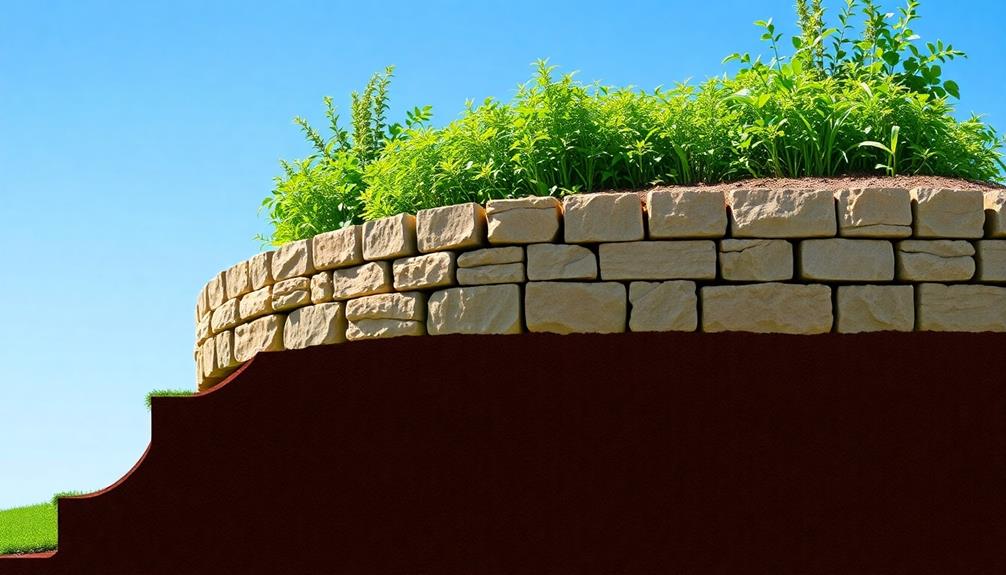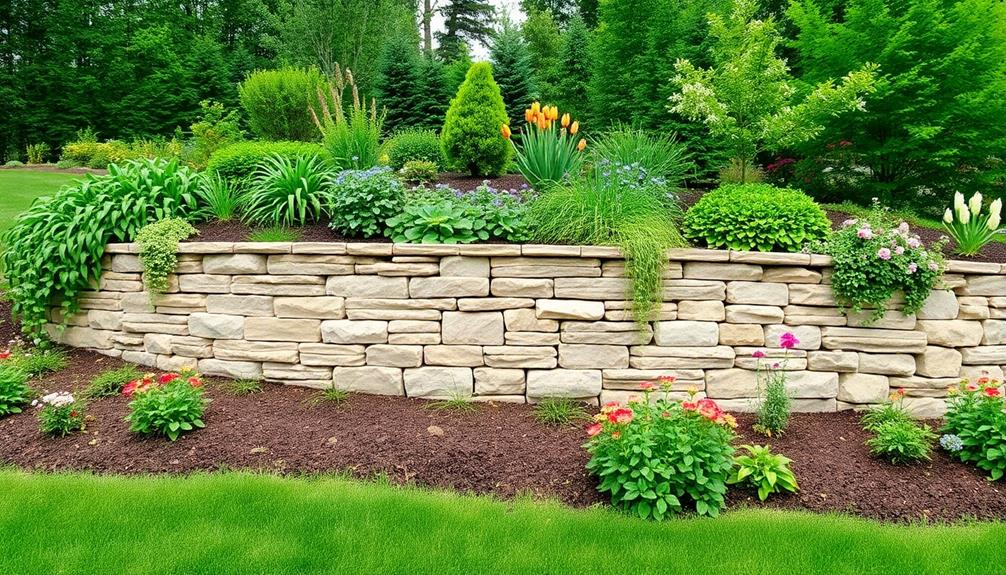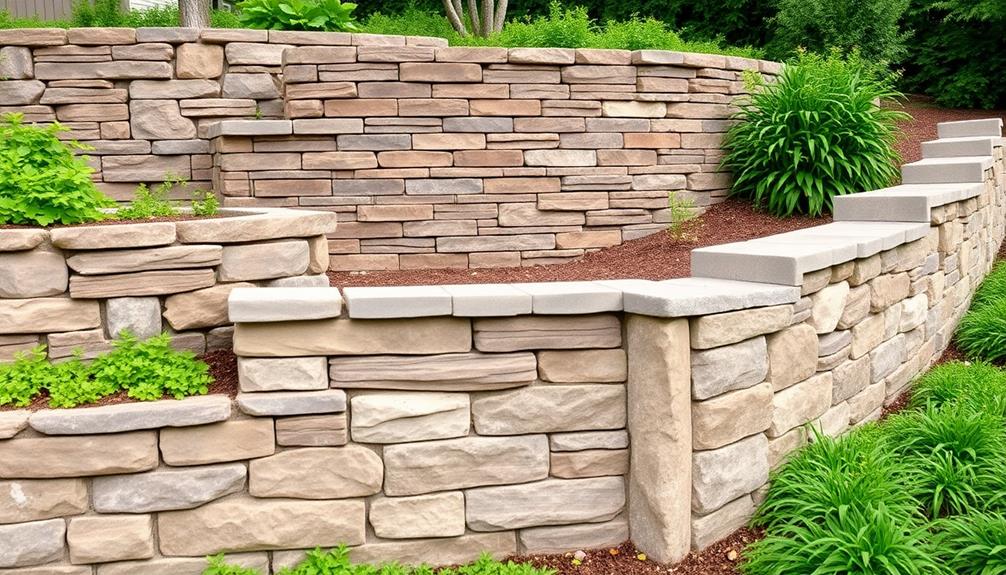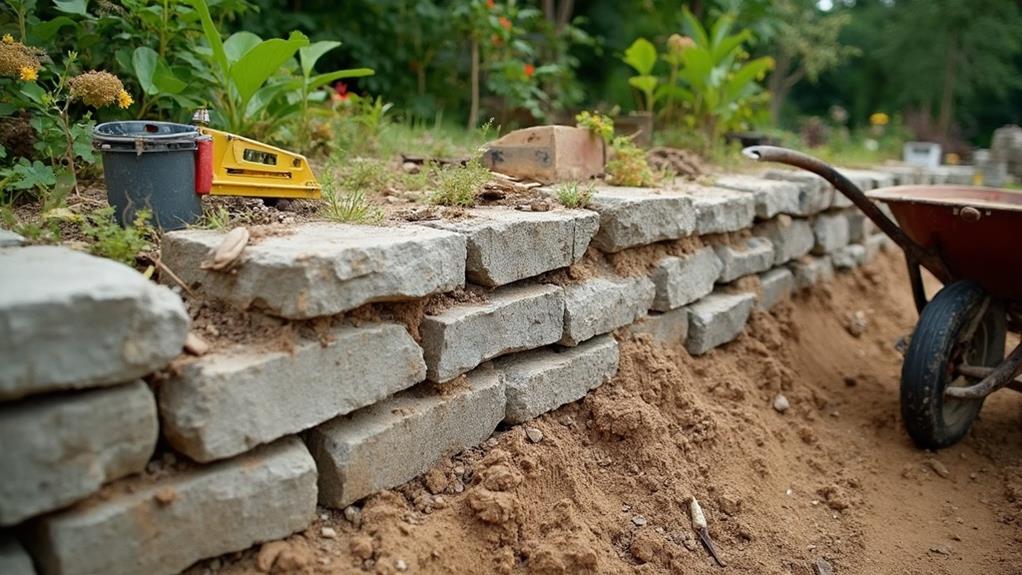Constructing a retaining wall involves several critical steps to guarantee durability and effectiveness. Begin with thorough site preparation, evaluating slope and soil conditions, and securing necessary permits. Excavate for a stable foundation, install a gravel base and drainage pipes, then lay a reinforced concrete footing below the frost line. Select appropriate materials for the wall, making certain the first course is level and plumb, and stagger vertical joints for stability. Backfill and compact soil, incorporating drainage systems with gravel and perforated pipes to manage water flow. Finish with capping materials and protective coatings, adhering to safety codes. Explore further to confirm complete mastery of the process.
Table of Contents
ToggleWalls Contractor Highlights
- Begin by assessing the site's slope, soil conditions, and other structures to ensure proper site preparation.
- Excavate the ground for a level foundation, install gravel bases, and secure any necessary permits.
- Construct the wall on a reinforced concrete footing, ensuring the footing extends below the frost line.
- Install proper drainage systems, including weep holes and perforated pipes, to manage water flow effectively.
- Finish with durable materials and landscaping, ensuring regular maintenance and adherence to safety codes.
Definition of Retaining Wall

A retaining wall is a pivotal structural element designed to support soil laterally, preventing erosion and managing slopes in landscaping projects. Retaining walls can be constructed with a variety of materials, each offering distinct aesthetic and functional benefits.
For instance, boulders and granite are popular choices due to their durability and ability to blend with natural surroundings, which is especially beneficial in areas with extreme weather. Additionally, retaining walls must align with the project's requirements and environmental conditions. Adherence to design principles and local regulations guarantees that the wall effectively fulfills its purpose while maintaining safety and durability standards.
Purpose and Function
Fundamentally, the purpose of a retaining wall is to provide indispensable structural support to impede soil erosion and landslides on sloped terrain. These walls serve as essential barriers, counterbalancing the lateral force of soil and maintaining stability in environments where slopes and embankments may pose potential threats to structures or landscapes below. By effectively restraining soil, retaining walls guarantee that landscaping remains intact and property boundaries are preserved. This support not only contributes to the security of the area but also enhances the aesthetic and functional utility of a given space.
Moreover, retaining walls function by redirecting water flow, a pivotal aspect in preventing surface runoff and reducing hydrostatic pressure, which might otherwise weaken soil consistency and lead to structural failure. In residential and urban settings, retaining walls can transform unusable slopes into viable landscape elements, providing flat surfaces for paths, gardens, or patios, thereby increasing the value and usability of a property.
As a community, the shared understanding of the protective and transformative potential of retaining walls connects us, promoting a safer, more harmonious interaction with the natural terrain. The strategic placement and construction of retaining walls are indispensable components in effective land management and urban planning.
Materials and Types
In considering the purpose and function of retaining walls, an understanding of the materials and types available is paramount. Retaining walls serve to stabilize soil, prevent erosion, and manage water runoff, consequently necessitating a judicious selection of materials to meet these objectives efficiently. The materials most commonly used include concrete, stone, brick, wood, and a variety of synthetic materials, each offering distinct advantages and characteristics that allow them to blend seamlessly into their environment while performing their structural duties.
Concrete retaining walls are favored for their strength and durability, capable of withstanding substantial pressure over time. Modular interlocking concrete blocks often provide versatility in design and ease of assembly.
Stone walls, meanwhile, evoke a sense of timeless elegance, resonating with a natural aesthetic that neighbors and passerby may find particularly appealing. Though they might require more labor to construct, their visual impact and resilience are worthwhile.
Alternatively, wood offers a rustic charm, commonly used for shorter walls or in garden landscapes due to its natural look and cost-effectiveness. Innovations in materials have introduced synthetic options like geogrid systems, which provide modern solutions for advanced retention needs in challenging terrains, fostering a harmonious integration of function and design.
Design and Regulations
When initiating the construction of a retaining wall, a clear understanding of the design principles and regulatory framework is crucial to guarantee both functionality and compliance. A retaining wall serves the fundamental purpose of stabilizing soil and preventing erosion by resisting the lateral pressure of earth. Its design involves integrating several elements such as aesthetics, structural integrity, drainage systems, and material choice.
Ensuring the wall's durability and effectiveness requires a balanced approach that considers the soil composition and topography of the intended site. Regulations play a critical role, dictating the permissible specifications and safety standards that must be adhered to during construction. Local building codes often require property owners to secure permits and possibly even engineer assessments, particularly if the wall exceeds a certain height or if it affects public pathways.
Designing within these legal frameworks not only safeguards one's investment but also contributes to community safety and cohesion. Ultimately, embracing the intricacies of design and regulatory compliance fosters a collective sense of security and belonging in a community, recognizing that each structure, down to a single retaining wall, integrates with broader urban or rural landscapes to sustain harmony and protection for all.
Benefits

Constructing a retaining wall offers a multitude of benefits that extend beyond mere structural support, primarily offering protection against soil erosion which can safeguard landscapes and properties from potential damage.
Additionally, such walls can considerably increase usable space on a property, allowing for more functional areas whether for gardening, recreation, or other purposes, while simultaneously enhancing the overall aesthetics through a well-designed integration with the existing landscape.
For example, using limestone wall installation not only prevents erosion but also adds an elegant and natural look to the yard.
In addition, retaining walls can greatly minimize the need for ongoing maintenance compared to unmanaged sloped terrain, therefore providing a long-term, efficient solution to landscape management challenges.
Prevents Soil Erosion
A well-constructed retaining wall serves as an essential structure in preventing soil erosion, offering significant benefits for both property owners and the environment. By holding soil in place, particularly on slopes and inclines, retaining walls mitigate the natural erosion process that can destabilize landscapes and undermine foundations.
As erosion proceeds, the ability of plants to anchor in the soil diminishes, which not only affects biodiversity but also can lead to landslides. Retaining walls provide a robust solution to these pressing issues.
Benefits of retaining walls in soil erosion prevention include:
- Stabilizes Slopes: They prevent the gradual wearing away of soil, confirming surrounding landscapes retain their form and function.
- Protects Foundations: By reducing soil movement, these walls play a pivotal role in safeguarding building foundations against potential damage.
- Minimizes Surface Runoff: The design of retaining walls controls and redirects water flow, reducing soil compaction and preventing topsoil erosion.
For communities and individuals who cherish their landscapes and desire to preserve their natural environment, investing in a retaining wall can establish a sense of stability. This framework of protection confirms the preservation of one's property, fostering a sense of belonging and continuity within a shared space.
Increases Usable Space
Beyond the protective benefits of retaining walls in preventing soil erosion, they also offer the advantageous creation of additional usable space. This increase in space is particularly valuable in areas with sloped landscapes, where the potential for practical land use is often limited.
By constructing a well-designed retaining wall, property owners can transform previously unusable or inefficient spaces into levelled terraces, opening new opportunities for landscaping, gardening, recreation, or even the expansion of living areas.
Retaining walls facilitate the reconfiguration of yards and properties in a way that maximizes functional outdoor space, making it more accessible and cohesive with the rest of the property. This is especially important in environments where homeowners seek to enhance the utility of their land while maintaining a sense of community and connectivity with their surroundings.
Additionally, these walls can support the creation of elevated zones that provide unique vantage points for observing the natural surroundings, fostering a deeper appreciation and connection with the environment.
In urban settings, retaining walls allow the conversion of encumbered land into valuable real estate, contributing to urban expansion strategies that emphasize efficient use of space, thus reinforcing our innate need for belonging and functionality in shared communities.
Enhances Property Aesthetics
Elevating the visual appeal of a property, retaining walls serve as both functional structures and design elements that enhance the overall aesthetics of outdoor spaces. These architectural features not only provide structural benefits but also imbue the landscape with an undeniable elegance and order. Through a blend of natural materials and expert craftsmanship, retaining walls can transform mundane exteriors into welcoming retreats.
Their versatility in design can complement existing themes, either standing as striking focal points or seamlessly integrating with the surrounding gardens.
Variety of Materials: Stone, brick, or wood can be selected to match architectural styles, allowing homeowners to create a harmonious link between their dwellings and outdoor environments.
Layered Landscapes: The construction of tiered garden beds introduces dynamic levels across a property, offering opportunities to cultivate vibrant plant life and establish unique visual interest.
Defined Spaces: Retaining walls clearly delineate areas within the landscape, adding structure and purpose to otherwise undifferentiated spaces, thereby promoting a sense of belonging and intentional design.
Incorporating retaining walls into the landscape invites a sense of personal touch and ownership over one's home environment, connecting both social and private spheres through thoughtfully composed outdoor spaces.
Minimizes Maintenance Needs
While enhancing property aesthetics is a significant advantage of retaining walls, their capacity to minimize maintenance needs is equally remarkable. Retaining walls are designed to be robust structures that effectively manage soil erosion, prevent landslides, and offer stability to landscapes that are otherwise prone to erosion. This inherent durability reduces the frequency of repairs and upkeep that homeowners need to undertake, fostering a lasting sense of security and reliability.
Constructed with high-quality materials such as stone, concrete, or timber, these walls create a solid barrier against the challenges posed by changing weather conditions and shifting soils. Their impermeability to moisture aids in mitigating issues related to water accumulation and the subsequent growth of unwanted vegetation, thus diminishing the need for continuous maintenance efforts.
Moreover, the strategic installation of drainage systems within the retaining wall structure guarantees that excess water is effectively managed, further upholding the wall's integrity and reducing potential deterioration over time. This proactive approach not only extends the lifespan of the wall but also lessens the long-term financial burden associated with ongoing property care. For those seeking a harmonious balance between aesthetic allure and practical functionality, retaining walls offer a compelling solution that inherently minimizes the demands of property maintenance.
Types of Retaining Wall Materials

When selecting materials for a retaining wall, it's vital to contemplate the unique benefits each option provides, such as the robustness of concrete blocks, the timeless beauty of natural stone, or the long-lasting reliability of timber. Each material not only influences the structural integrity and aesthetic appeal of the wall but also reflects homeowner preferences and the environmental context of the installation. The following table succinctly outlines the key considerations to inform your decision:
| Material Type | Key Consideration |
|---|---|
| Concrete Block | Superior strength |
| Natural Stone | Aesthetic elegance |
| Timber Wall | Long-term durability |
| Maintenance Needs | Varies by material choice |
| Cost Implications | Influences overall budget |
Concrete Block Benefits
Choosing the right material is fundamental to the durability and effectiveness of any retaining wall, and concrete blocks offer a range of benefits that make them a popular choice. Among construction enthusiasts and homeowners alike, concrete blocks are esteemed for their impressive combination of strength, versatility, and ease of installation. Understanding their advantages can foster an informed decision-making process that aligns with your environmental and structural goals.
Concrete blocks provide significant advantages, including:
- Durability: Being robust and long-lasting, concrete blocks furnish a sturdy foundation that can withstand environmental pressures, ensuring the structural integrity of retaining walls over time.
- Design Flexibility: Available in various shapes and sizes, concrete blocks allow for creative freedom, accommodating unique aesthetic desires while meeting functional requirements without compromising stability.
- Cost-Effectiveness: The relative affordability of concrete blocks, compared to other materials, offers a budget-friendly solution without sacrificing quality or performance, making them accessible for a wide range of projects.
These benefits contribute to a sense of belonging within a community of skilled builders and knowledgeable homeowners who appreciate practical solutions. Concrete block retaining walls not only enhance your landscape's appearance but also deliver reliability and durability that communities can trust, creating shared spaces that stand the test of time.
Natural Stone Appeal
Embodying a timeless elegance, natural stone provides both aesthetic allure and robust functionality, making it a highly sought-after material for retaining walls. The organic textures and colors of natural stone blend seamlessly into various landscape designs, creating a harmonious visual continuity that beckons a sense of belonging to the environment.
This appeal is not merely superficial; the intrinsic strength of stones like granite, limestone, and sandstone guarantees structural resilience against soil pressure, weather fluctuations, and erosion over time.
The versatility in application is remarkable; stones can be dry-stacked to allow for natural drainage or mortared for enhanced stability, each technique offering distinct aesthetic and functional advantages. Additionally, the range of available stone types allows for a custom approach to meet specific site conditions and aesthetic preferences. With styles spanning rustic to contemporary, natural stone complements diverse architectural themes, providing a cohesive look that ties the landscape together seamlessly.
The enduring nature of natural stone also extends to minimal maintenance requirements, further enhancing its appeal for retaining wall projects. It conveys a sense of permanence, echoing the timeless landscapes it seeks to preserve and fortify, thereby reinforcing its role as a cherished choice among discerning builders and homeowners.
Timber Wall Durability
Crafting a retaining wall from timber combines affordability with aesthetic warmth, offering a practical solution for many landscaping projects. However, the durability of timber walls is contingent upon several factors which, when addressed properly, can guarantee long-lasting performance and beauty. Key aspects to consider include the type of timber used, treatment processes, and environmental conditions impacting the structure's longevity.
To boost durability, selecting the appropriate timber is paramount. Options such as cedar or redwood offer natural resistance to decay and insects, while treated pine provides a cost-effective alternative with substantial longevity when installed and maintained correctly. Here are some points to ponder:
- Selection of timber species: Determines inherent resistance to decay.
- Treatment methods: Pressure treatments can dramatically extend the lifespan.
- Maintenance practices: Regular inspections and sealing can prevent moisture damage.
Environmental exposure also plays a decisive role. Timber retaining walls in high-moisture areas may require additional protective coatings to fend off rot and degradation. By devoting due attention to these factors and applying conscientious maintenance practices, homeowners and landscapers can preserve the structural integrity and visual appeal that timber walls bring to outdoor spaces, fostering a sense of belonging within a beautifully curated landscape.
Walls Contractor FAQ
What Tools Will I Need to Build a Retaining Wall?
To effectively build a retaining wall, you will require a level, string line, wheelbarrow, shovel, tamper, hammer, and protective gear. Embrace this opportunity to build a durable structure that harmonizes with your landscape and community.
How Do I Determine the Height of My Retaining Wall?
Determining the height of your retaining wall involves evaluating soil stability, slope gradient, and design requirements. Consult local building codes and regulations, and consider engaging with a professional engineer to guarantee safety and compliance with all necessary guidelines.
What Safety Precautions Should I Take When Constructing a Retaining Wall?
When constructing a retaining wall, prioritize safety by ensuring proper equipment use, wearing protective gear, maintaining site cleanliness, and adhering to stability guidelines. Engage helpful communities and experts for guidance, creating a secure and supportive construction environment.
How Do I Ensure Proper Drainage Behind the Retaining Wall?
To guarantee proper drainage behind a retaining wall, incorporate a drainage pipe at the wall's base, backfill with gravel or drainage aggregate, and apply a geotextile fabric to prevent soil clogging, fostering reliable long-term structural performance.
What Permits May Be Required to Build a Retaining Wall in My Area?
To determine necessary permits for constructing a retaining wall in your area, consult local building authorities or municipal websites. Requirements may vary based on wall dimensions, location, and zoning regulations, ensuring compliance fosters community harmony and safety.







